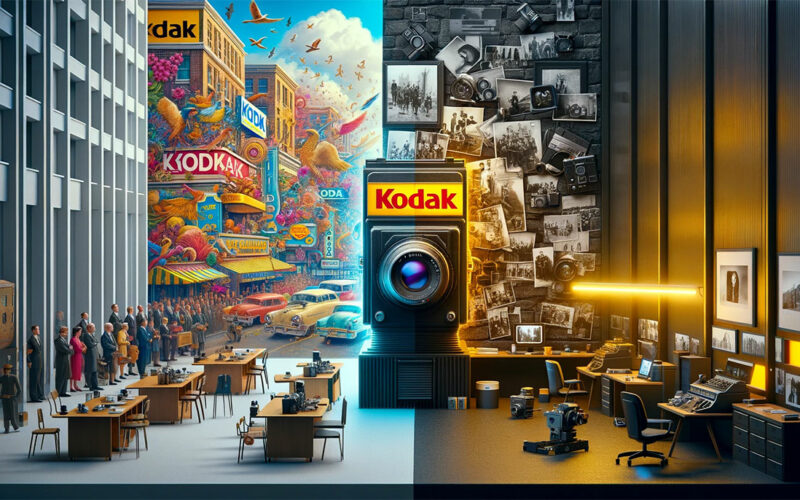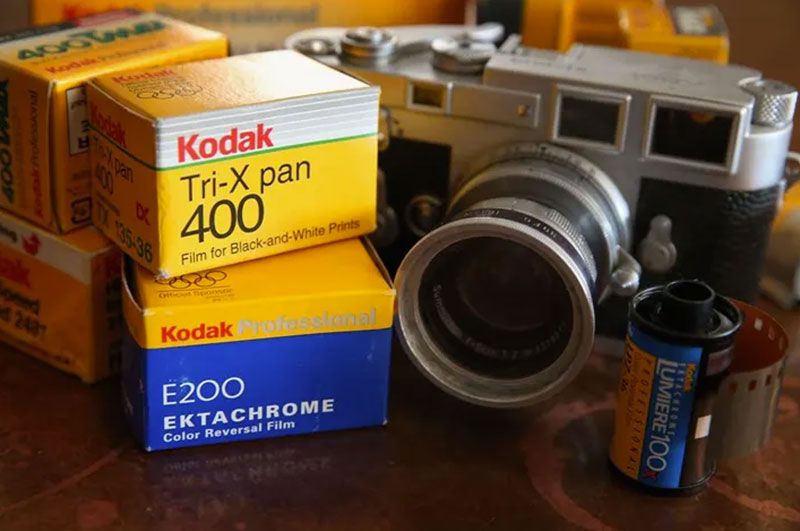Missed Snapshots: What Happened to Kodak?

Let’s kick things off with a snapshot of the past. Picture this: the late 1800s, a world buzzing with new ideas. In the midst of all this, a little company called Kodak pops up. They weren’t just another face in the crowd; they were trailblazers, setting the scene in the photography industry.
Imagine a world without selfies, no snaps, no pics. Boring, right? Well, Kodak stepped in and changed the game. They made photography a piece of cake for everyone. “You press the button, we do the rest,” they said. And boy, did they deliver!
It’s like, one day you’re scribbling on cave walls, and the next, you’re capturing moments with a click. Kodak was dropping innovations like they were hotcakes: the first handheld camera, color film rolls, you name it. They were the big cheese, the talk of the town.
Now, this is where things get juicy. Enter the age of pixels and bytes.
Picture a young dude named Steve Sasson, tinkering in a lab. He’s like, “Let’s make a camera but, like, digital.” And bam!
The digital camera is born. But here’s the kicker: it was Kodak’s own playground where this baby was invented.
So, what happened to Kodak when their own guy came up with this tech? It’s like having a golden ticket but just staring at it. They patted Steve on the back and went, “Cool story, bro,” but kept selling those film rolls like hotcakes.
The Rise of Digital Photography
Technological Advancements
Fast forward a bit, and digital cameras are popping up like mushrooms after rain.
The Evolution of Digital Cameras
We’re talking tiny pixels turning into mighty megapixels, storage going from “Oops, it’s full” to “Shoot all day!” Digital cameras were becoming the new cool kid on the block.
The Shift from Film to Digital

It’s like everyone got the memo except Kodak. People were ditching film like last season’s fashion. Digital was in, and film was out. That was the market’s new mantra.
Market Dynamics
Oh boy, the market was like a wild party everyone wanted in on.
Consumer Adoption of Digital Photography
People were like kids in a candy store with digital cameras. Snapping, clicking, sharing – photography was no longer a chore.
It was fun, fast, and freakishly addictive.
Competition from New Market Entrants
Meanwhile, new players were jumping into the fray. You had tech giants and startups alike going, “Move over, Kodak. We got this.”
The competition was heating up, and the market dynamics were shifting faster than a cheetah on a sugar rush.
Kodak’s Strategic Missteps

Ignoring Digital Disruption
So here we are, at the crossroads where Kodak’s plot twist kicks in. It’s like they were chilling on a boat without noticing the storm ahead.
The 1981 Market Intelligence Study
Let’s rewind to 1981. Kodak’s got this report, right? It’s like a crystal ball showing them the future. It says, “Hey, digital’s gonna take over by 2010.” Did they listen? Nope.
It’s like getting a text from the future and leaving it on ‘read’.
Kodak’s 10-Year Window of Opportunity
So, there was this 10-year window, a golden chance for Kodak to jump on the digital train. But what happened to Kodak?
They missed the memo. Sat on their hands. By the time they looked up, the digital revolution train had left the station.
Failed Innovations and Investments
Okay, so Kodak wasn’t totally snoozing. They tried some stuff, but it was like swinging in the dark.
The Advantix Preview System
Remember the Advantix Preview system? No? Well, that tells you something. It was this hybrid of film and digital.
But it was like rocking a flip phone when everyone else had smartphones. Not cool.
The Acquisition of Sterling Drug
Then there was this wild move: Kodak buys a drug company. Yeah, you heard that right. Sterling Drug.
It’s like a baker trying to fix cars. People were scratching their heads, asking, “What happened to Kodak’s game plan?”
Leadership and Decision-Making
Now, the captains of this ship, the CEOs, they kept changing. And with each new captain, the ship’s direction went all wobbly.
CEO Choices and Their Impact
Each CEO had a different map, a different destination in mind. But none seemed to have a GPS lock on the digital world.
Lack of Organizational Agility
And let’s talk agility. Kodak was like a giant elephant trying to win a hurdle race.
They saw hurdles, alright, but leaping over them? Nah, too much effort.
The Fall of a Giant
Financial Struggles
Now we hit the rough patch, the stormy weather. Kodak’s wallet was feeling the pinch.
Decline in Film Sales
Film sales were diving faster than a peregrine falcon. What happened to Kodak’s bread and butter? Digital photography happened, that’s what. But Kodak was still banking on those film rolls.
Bankruptcy Filing
Then, boom! 2012 hits, and Kodak’s filing for bankruptcy. It’s like the end of an era, the closing of a massive chapter in photography history.
Kodak’s Attempts to Pivot
But wait, there’s a twist. Kodak’s down, but not out. They’re trying to swing back.
Ventures into the Mobile Industry
First, they’re eyeing the mobile industry. Phones with cameras are the new rave, and Kodak’s like, “Let’s get in on that action.”
But it’s a bit late to the party, and the room’s already packed.
Patent Lawsuits and Other Efforts
And then there’s this battle of patents. Kodak’s throwing lawsuits left, right, and center, hoping to cash in on their inventions.
It’s a bit like finding loose change under the couch cushions, though. Helps a bit, but won’t buy you a new couch.
Lessons Learned from Kodak’s Failure
The Importance of Innovation
Let’s break it down, innovation isn’t just a cool buzzword.
Embracing Disruptive Technologies
Picture this: there’s a new gadget on the block, changing the game. What do you do? Sit back and watch?
Nope.
You dive in, get your hands dirty, and ride the wave. That’s what Kodak missed. They saw digital photography coming, but they just gave it a nod and went back to their old-school film rolls.
The Need for Strategic Creativity
Strategic creativity sounds fancy, but it’s simple. It’s about thinking outside the box, like way outside.
It’s looking at a camera and saying, “What else can you do?” Kodak needed more of that ‘What else’ mindset.
Organizational Adaptability
Change is like the weather; it’s always happening. The trick is to dance in the rain instead of waiting for the storm to pass.
The Role of Leadership in Change Management
Leaders, they’re like the captains of a ship. They need to see the storm coming and steer the ship safely.
Kodak’s captains, well, they saw the storm but didn’t turn the wheel in time.
Building an Enterprise Mindset Open to Change
It’s all about the mindset. An enterprise that’s open to change is like water, flowing and filling up new spaces.
Kodak was more like ice, solid and slowly melting away.
Insights from “The Decision Loom”
You’ve got data, reports, and all this info. What now? That’s where “The Decision Loom” comes in. It’s like a playbook for making the right moves.
Effective Decision-Making in Organizations
Decisions are the steering wheel for any business.
Make the right ones, and you’re cruising; make the wrong ones, and you’re in a ditch. Kodak, well, they didn’t turn the wheel enough.
Turning Market Intelligence into Strategic Action
Market intelligence is like a treasure map. It’s not enough to just have it; you’ve got to follow it to find the gold. Kodak had the map but didn’t take enough steps.
FAQ On What Happened To Kodak
Why Did Kodak Fail?
Kodak pretty much missed the boat on digital. They were chilling, thinking film was forever, but then digital swooped in. They invented it, mind you, but just couldn’t pivot. Classic tale of a giant that just couldn’t dance to the new beat.
Did Kodak Invent the Digital Camera?
So, this is kind of an “own goal” story. Kodak engineer Steve Sasson actually cobbled together the first digital camera back in ’75. But Kodak? They were all in on film and kinda just patted him on the back and moved on. Talk about a missed opportunity, huh?
Could Kodak Have Avoided Bankruptcy?
In hindsight, yeah, they had a shot. They got this heads-up from a market study in ’81, basically a crystal ball saying digital’s gonna take over. But they kinda just shrugged. If they’d jumped on it, beefed up their digital game, who knows?
How Did Kodak’s Bankruptcy Affect the Photography Industry?
Kodak hitting the bankruptcy button was like a shockwave. It was a wake-up call, loud and clear, to the industry. If Kodak could fall, anyone could. So, you saw companies doubling down on digital, innovation, and staying light on their feet.
What Was Kodak’s Biggest Mistake?
You could say their biggest boo-boo was ignoring the digital disruption. They had the tech, the brains, and the brand. But they were comfy, too comfy in their film throne. When digital started creeping up, they kinda just… yawned.
Did Kodak Stop Making Film?
Not completely, no. They trimmed down, but there’s still some film rolling out. It’s more of a niche thing now, for enthusiasts and artists. But the heyday of film being everywhere? That’s a snapshot from the past.
What Is Kodak Doing Now?
Kodak’s like that band that had a big hit and now they’re trying new tunes. They’ve dipped their toes in various waters – digital printing, brand licensing, even some blockchain stuff. They’re trying to find that second wind.
Who Owns Kodak Now?
Kodak’s still its own boss, just a lot leaner. They’ve got investors and stakeholders, sure, but there’s no single big kahuna owning the whole show.
Is Kodak Still a Relevant Brand?
They’ve got legacy, no doubt. They’re not the Goliath they once were, but they’ve still got some game. There’s brand recognition, nostalgia, and a bit of that underdog spirit now.
What Lessons Can Be Learned from Kodak’s Downfall?
Oh, loads! The biggie is to stay awake at the wheel. Innovation, adaptability, and really listening to what the market’s whispering, sometimes screaming. Complacency is like quicksand for businesses.
Conclusion On What Happened To Kodak
So, here’s the deal. Kodak wasn’t just a company; it was like a giant in a land of photography dwarfs. They were the big cheese, the head honcho of the camera world.
They didn’t just make cameras and film; they revolutionized memories. Before them, capturing a moment was no cakewalk. Kodak made it as easy as pie. They were all about innovation, quality, and making sure anyone could snap a pic.
What happened to Kodak isn’t just a blip in history. It’s like a landmark, a signpost. They’re not just remembered for what they did right but also for the curveball they missed.
Now, buckle up, ’cause here’s the kicker.
Kodak’s story is like a campfire tale for businesses. It’s about the boogeyman of complacency and the heroics of adaptability. It’s a reminder that no matter how big you are, there’s something bigger: change.
This isn’t just a tale for the history books. It’s as relevant today as a trending hashtag. In this digital age, where tech changes faster than fashion, what happened to Kodak is a nudge, a whisper in the ear saying, “Keep moving, or get left behind.”
If you liked this article about what happened to Kodak, you should check out this article about what happened to Saab.
There are also similar articles discussing what happened to Sports Authority, what happened to Atari, what happened to Newsweek, and what happened to JCPenney.
And let’s not forget about articles on what happened to Sun Microsystems, what happened to Woolworths, what happened to RadioShack, and what happened to Virgin America.
- Drive and Earn: Essential Apps Like Doordash - May 8, 2024
- The Benefits of Integrating Geofencing with CRM Systems - May 8, 2024
- Create Your Game: The Best JavaScript Game Engines - May 8, 2024








